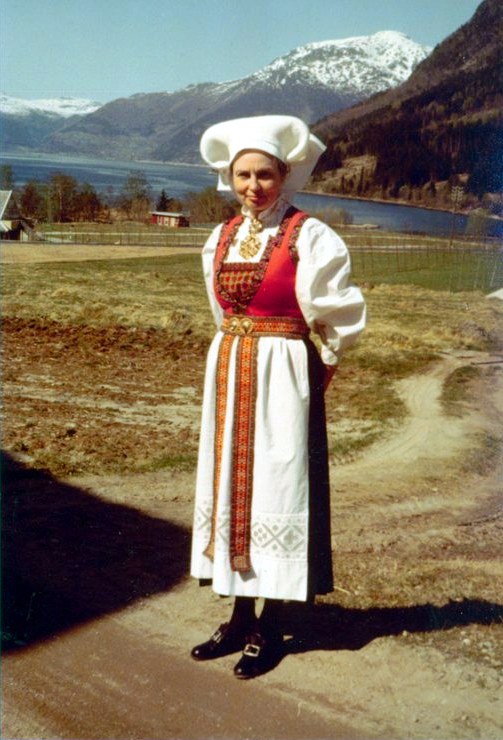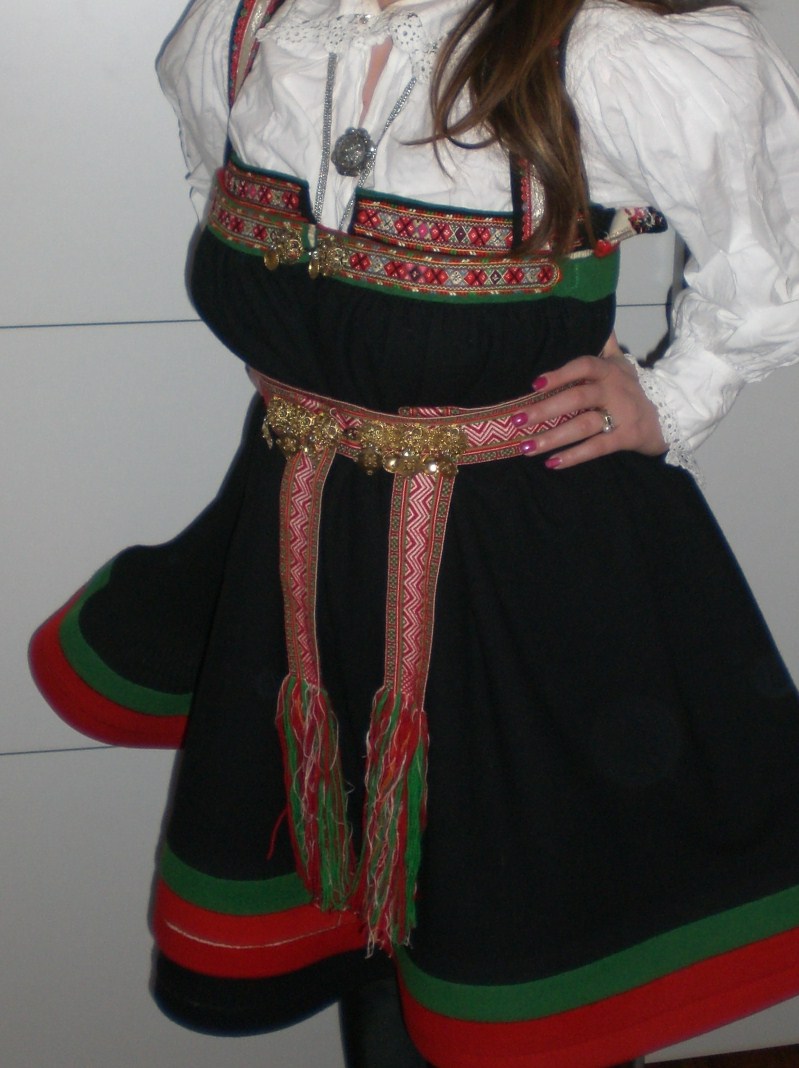|
Bunad
''Bunad'' (, plural: ''bunader''/''bunadar'') is a Norwegian umbrella term. In a broader sense, the term encompasses household, householding equipment, and livestock as well as both traditional rural clothes (mostly dating to the 18th and 19th centuries) and modern 20th-century folk costumes. In its narrowest sense, the word ''bunad'' refers only to clothes designed in the early 20th century that are loosely based on traditional costumes. The bunad movement has its root in 19th-century national romanticism, which included an interest for traditional folk costumes not only in Norway, but also in neighbouring countries such as Denmark and notably Germany. However, in Norway, national romanticist ideas had a more lasting impact, as seen in the use of folk-inspired costumes. History The bunad movement has been carried forward by enthusiasts all over the country and new bunad variations are frequently created and proposed for approval. Designers such as Lise Skjåk Bræk have ... [...More Info...] [...Related Items...] OR: [Wikipedia] [Google] [Baidu] |
Folk Costume
Folk costume, traditional dress, traditional attire or folk attire, is clothing of an ethnic group, nation or region, and expresses cultural, religious or national identity. An ethnic group's clothing may also be called ethnic clothing or ethnic dress. Traditional clothing includes everyday and formal wear. The word "costume" in this context is sometimes considered pejorative, as the word has more than one meaning, and thus "clothing", "dress", "attire" or "regalia" can be substituted without offense. Following the rise of romantic nationalism in parts of Europe, pre-industrial peasantry came to serve as ideals for genuinity and desirability. Garments evoking peasant dress were made from traditional pre-industrial textiles. In regions where Western dress styles are common, traditional garments are often worn during special events or celebrations. International events may cater to non-Western attendees with a compound dress code such as "business suit or national dress". In s ... [...More Info...] [...Related Items...] OR: [Wikipedia] [Google] [Baidu] |
Setesdalsbunad
Setesdalsbunad or ''women's folk costume from Valle in Setesdal'' as the original name, is a costume based on the costume traditions of Valle in Aust-Agder, Norway. In addition, this costume is one of the oldest costumes that have been used continuously for years, both in everyday life and for party use. Today is the Setesdalsbunad remains as an outfit to mark an anniversary, among them the Norwegian Constitution Day on 17 May each year. In addition, there is also a traditional Setesdalsbunad used by men. The male version is characterized by the back part which partially is made of leather. in Norwegian Gallery: Setesdalsbunad [...More Info...] [...Related Items...] OR: [Wikipedia] [Google] [Baidu] |
Hardangerbunad
Hardangerbunad is a collective term for bunads from the villages in the traditional district of Hardanger, Norway, with various local varieties. The bunad includes the areas Kvam, Granvin, Ulvik, Eidfjord, Jondal, Ullensvang and Odda. Hardanger is one of the areas in Norway that has had a strong folk costume tradition, and with the national romantic in the late 1800s, the church clothes from this area were lifted to be a Norwegian national symbol, and the Hardangerbunad therefore has the nickname ''Nasjonalen'', in English "The National". The Hardangerbunad was used by women from all over Norway to show support for dissolution of the union between Norway and Sweden in 1905.''Hol Haugen, Bjørn Sverre'' (2006). Norsk bunadleksikon. N.W. Damm & Søn. Female bunads The bunads for women have black skirt, and are found in party variants with red or green bodice and white apron, or black bodice and black apron. Over large parts of the bunad, including the belt and apron, there is ... [...More Info...] [...Related Items...] OR: [Wikipedia] [Google] [Baidu] |
Valdres Folkemuseum
The Valdres Folkemuseum is a folk museum located at Storøya, Oppland, Storøya outside Fagernes in Nord-Aurdal in Innlandet county, Norway. Overview Valdres Folk Museum was founded in 1901. It is located in the traditional rural district of Valdres. The museum is on a small ridge reaching out into Strandefjorden, with the larger buildings closest to the entrance and with smaller farm houses up on the slightly higher area reaching out into the lake. There are 95 houses and other constructions, comprising around 20,000 items, and the museum is the fourth largest Norwegian outdoor museum. All the items in the museum are original and have been collected from various farms and other locations in the area. Valdres Folk Museum hosts various cultural events including folk music festivals, seminars and open air theatre. During 2010, a new reception building was opened and linked to the administration building. The museum runs several subsidiaries including Bagn Bygdesamling and Baut ... [...More Info...] [...Related Items...] OR: [Wikipedia] [Google] [Baidu] |
Norwegian Romantic Nationalism
Norwegian romantic nationalism () was a movement in Norway between 1840 and 1867 in art, literature, and popular culture that emphasized the aesthetics of Norwegian nature and the uniqueness of the Norwegian national identity. A subject of much study and debate in Norway, it was characterized by nostalgia. Background The context and impact of Norwegian romantic nationalism derived from recent history and the political situation. Following the Black Plague, Norway became dependent on Denmark and Copenhagen was made capital of both countries in a personal union. Subsequently, there was a brain drain of talented people from Norway to Denmark, who studied in Copenhagen and became intellectuals and cultural icons in Denmark, most famously Ludvig Holberg. After more than 400 years as a dependent lesser part in the Denmark-Norway union treated as a cultural backwater by the absentee government in Copenhagen, the only uniquely Norwegian culture was found among the farmers and peasan ... [...More Info...] [...Related Items...] OR: [Wikipedia] [Google] [Baidu] |
Setesdal
Setesdal (; older name: Sætersdal) is a valley and a traditional district in Agder County in southern Norway. It consists of the municipalities of Bykle, Valle, Bygland, Iveland, and Evje og Hornnes. The Otra river flows through the valley of Setesdal into the sea near Kristiansand. It flows southward from the Hardangervidda plateau in Telemark. The historic Setesdal starts at Evje and extends as far as the farm Bjåen, at the edge of the traditional region of Telemark. Øvre (Upper) Setesdal is in the municipality of Bykle. The municipalities of Iveland, Evje & Hornes and Bygland comprise the Nedre (Lower) Setesdal. Valle municipality is in the middle of the Setesdal valley. Norwegian National Road 9 runs through Setesdal. Etymology The oldest Norse form of the name was just ''Setr'', and this was later replaced by ''Setrsdalr'' ('the dale/valley of Setr'). The common word ''setr'' has the meaning 'homestead, farm' – and ''Setr'' was probably originally the name o ... [...More Info...] [...Related Items...] OR: [Wikipedia] [Google] [Baidu] |
Norwegian Constitution Day
Constitution Day is the national day of Norway and is an official public holiday observed on 17 May each year. Among Norwegians, the day is referred to as ''Syttende mai'' ("Seventeenth of May"), ''Nasjonaldagen'' ("National Day"), or ''Grunnlovsdagen'' ("Constitution Day"), although the latter is less frequent. The Norwegians will often celebrate with big parades with everyone dressed up in their special outfit (bunad). People eat hot dogs, waffles and ice cream and the children play playground games. Historical background The Constitution of Norway was signed at Eidsvoll on 17 May 1814. It is the third oldest written constitution still in use. The constitution declared Norway to be an independent kingdom in an attempt to avoid being ceded to Sweden after Denmark–Norway's devastating defeat in the Napoleonic Wars. This established a Union between Sweden and Norway. The celebration of this day began spontaneously among students and others from early on. However, Norway ... [...More Info...] [...Related Items...] OR: [Wikipedia] [Google] [Baidu] |
Faroe Mini-sheet 1
{{disambiguation ...
Faroe may refer to: Places * Faroe Islands, an archipelago in the North Atlantic and a part of the Kingdom of Denmark **Faroese people ** Faroese language * Danish ship ''Færøe'' * Fårö, an island off Gotland, Sweden * Farø, an island south of Zealand, Denmark Arts, entertainment, and media * Faroe, southernmost main island in the Skellige archipelago in The Witcher 3 video game by CD Projekt See also * Pharaoh (other) Pharaoh is the title of ancient Egyptian monarchs. Pharaoh, Pharao or Pharoah may also refer to: Arts and entertainment Film and literature * Pharaoh (Prus novel), ''Pharaoh'' (Prus novel), a book a 1897 by Bolesław Prus ** Pharaoh (film), ''P ... [...More Info...] [...Related Items...] OR: [Wikipedia] [Google] [Baidu] |
Margrethe II Of Denmark
Margrethe II (; Margrethe Alexandrine Þórhildur Ingrid, born 16 April 1940) is a member of the Danish royal family who reigned as Queen of Denmark from 14 January 1972 until Abdication of Margrethe II, her abdication on 14 January 2024. Having reigned for exactly 52 years, she was the second-longest-reigning Danish monarch after Christian IV. Margrethe was born into the House of Glücksburg, a cadet branch of the House of Oldenburg, during the reign of her paternal grandfather, Christian X of Denmark, King Christian X. She is the eldest child of King Frederik IX and Queen Ingrid. She became heir presumptive to her father in 1953 when Act of Succession (Denmark), a constitutional amendment allowed women to inherit the throne. In 1967, she married Henri de Laborde de Monpezat, with whom she had two sons, Frederik X, Frederik and Prince Joachim of Denmark, Joachim. Margrethe succeeded her father upon his death in January 1972. Margrethe has worked as a scenographer, a costume ... [...More Info...] [...Related Items...] OR: [Wikipedia] [Google] [Baidu] |
Thorvald Stoltenberg
Thorvald Stoltenberg (8 July 1931 – 13 July 2018) was a Norwegian politician and diplomat. He served as Minister of Defence from 1979 to 1981 and Minister of Foreign Affairs from 1987 to 1989 and again from 1990 to 1993 in two Labour governments. From 1989 to 1990, Stoltenberg served as the Norwegian ambassador to the United Nations. In 1990, he became the United Nations High Commissioner for Refugees, serving for one year after which he rejoined the Norwegian government. In 1992, Stoltenberg, together with nine Baltic ministers of foreign affairs and an EU commissioner, founded the Council of the Baltic Sea States (CBSS) and the EuroFaculty. In 1993, he was appointed Special Representative of the UN Secretary-General for the former Yugoslavia and U.N. Co-Chairman of the Steering Committee of the International Conference on the former Yugoslavia. Thorvald Stoltenberg was also the UN witness at the signing of Erdut Agreement. In 2003 he was appointed chairman of the board ... [...More Info...] [...Related Items...] OR: [Wikipedia] [Google] [Baidu] |






